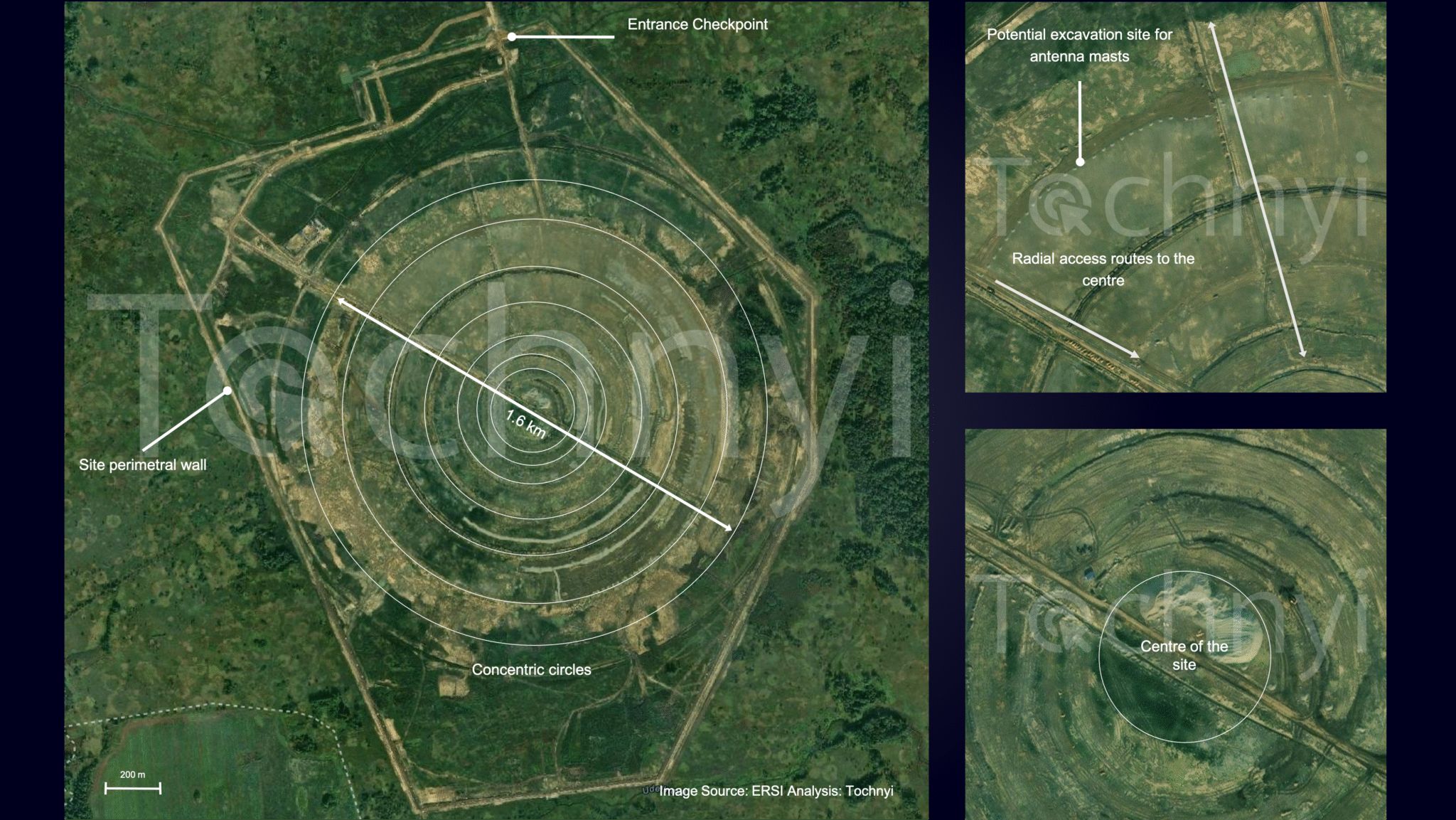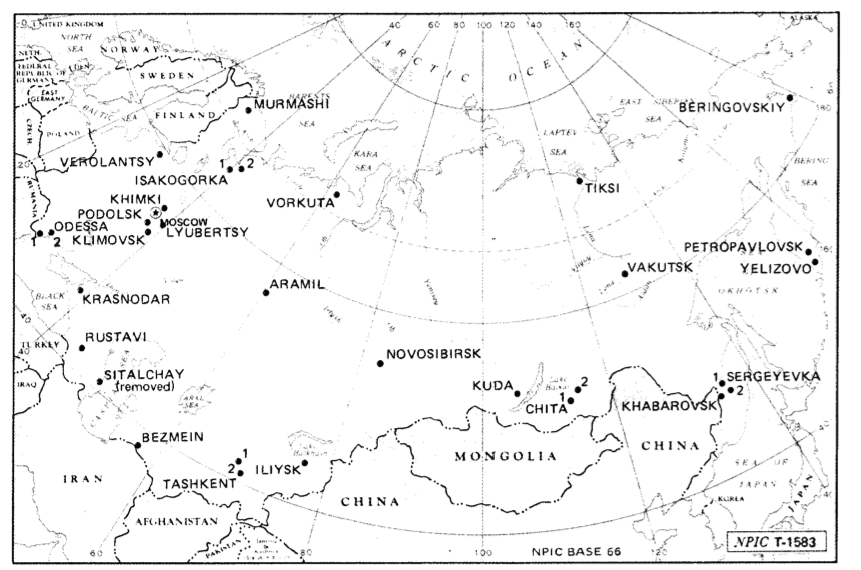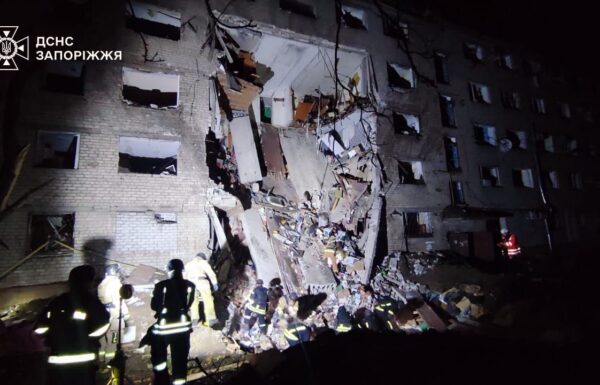On Friday, August 15, 2025, a group of OSINT experts associated with the Tochnyi.info portal published an analysis of satellite images of a mysterious antenna complex, which has been under construction by the Russian military since 2023 in the Kaliningrad region, just 25 km from the Polish border. According to them, the facility could potentially serve in the future to track NATO’s electronic communications in Europe. The satellite images reveal a facility distinct from conventional radar stations, suggesting a highly specialized structure with a military purpose.
 Current state of construction / Photos: ERSI Analysis, Tochnyi.info
Current state of construction / Photos: ERSI Analysis, Tochnyi.info
The circular-shaped facility, with an outer diameter of up to 1,600 meters, is being constructed on a deforested, uninhabited area, 3 km from the Gusiev military garrison, which houses the headquarters of the 11th Army Corps, along with the 79th Independent Mechanized Brigade, the 11th Independent Tank Regiment, and ammunition depots.
At present, six concentric circles can be identified, along with radial access roads and a fortified perimeter. The geometry of the facility indicates that it is a so-called Circularly Disposed Antenna Array (CDAA). The concept itself is not new; such facilities were built as far back as the Soviet era under the ‘Krug’ (Russian for ‘Circle’) program, which involved the construction of 31 installations across the country to intercept and analyze radio signals (Signals Intelligence, SIGINT). Interestingly, the idea was not initially Soviet but based on German Wullenweber technology.
The system consisted of a circular antenna field with an outer diameter of only 200–300 meters, comprising 40 towers with dipole, monopole, or loop antennas, surrounded by a 105-meter vertical screen resembling a fence. This configuration enabled the precise determination of the direction of radio signal sources and their reception. The effective range of such an antenna system was over-the-horizon, reaching up to 7,400 km. The Krug project was used not only for signals intelligence but also for communication with submerged submarines and for mapping NATO’s command and communication infrastructure.
According to analyses by the U.S. Central Intelligence Agency (CIA), the Soviet Krug system was supplemented by several other types of antenna installations, such as the Fix-24 – a smaller, dual-band system with concentric rings of 150–200 meters in diameter – and the compact ‘Thick Eight,’ which used only eight cage antennas. These systems were deployed not only in the USSR but also in other Warsaw Pact countries and in China.
 Deployment of Krug antenna systems / Map: CIA
Deployment of Krug antenna systems / Map: CIA
According to some analyses, the Krug project, due to its parameters, may have been partially linked to the over-the-horizon radar system Duga, project 5N77 (NATO reporting name: Steel Yard), deployed in the former Ukrainian SSR in the areas of Kalinovka near Mykolaiv, Chernobyl, and Lubech, as well as Veliky Kartel in the Khabarovsk region of the Russian Far East. The system was known as the ‘Eye of Moscow’ or the ‘Russian Woodpecker’ and ceased operation in 1989.
As for the newly emerging military installation in the Kaliningrad region, OSINT analysts first observed activity related to its construction on March 18, 2023. Subsequent satellite images analyzed are dated April 7, 2023, May 7, 2023, July 3, 2023, and, after longer intervals, July 10, 2024, and July 22, 2025.
 Construction progress
Construction progress
The placement of such a strategic facility in Russia’s westernmost region – an exclave located between Poland, Lithuania, and the Baltic Sea – appears to be a logical move from Moscow’s perspective. It could enable the Russian armed forces and military intelligence to monitor communication systems in NATO’s European sector, as well as provide communications through Very Low Frequency (VLF) and Low Frequency (LF) transmitters with submerged submarines operating in the Baltic Sea, the North Sea, and the North Atlantic.
Monitoring NATO through passive intelligence gathering would be consistent with Russia’s broader doctrine of electronic warfare (EW), which forms a core element of its modern hybrid warfare strategy and sub-threshold operations.
Experts from Tochnyi.info compared the architecture of the facility with an active installation in Bramstedtlund, Germany, in the federal state of Schleswig-Holstein, Nordfriesland district, which has an outer diameter of 410 meters, and with a Russian installation launched in November 2017 in occupied Crimea near Sevastopol, with a diameter of 190 meters and consisting of 16 antennas.
They emphasize that the new installation in the Kaliningrad region will likely become the central hub of Russia’s signals intelligence and strategic communications architecture on the western front, operating just 25 km from NATO’s border.































